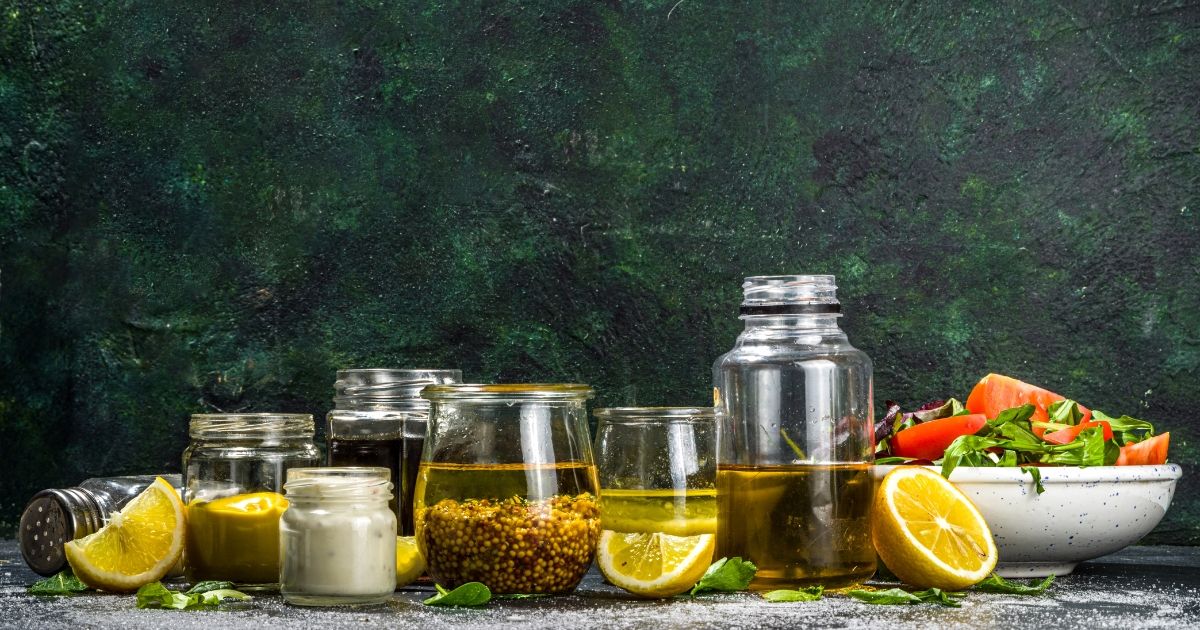The Ultimate Guide to Salad Dressing Varieties: Make Every Salad an Adventure!
Dive into the world of salad dressings with our comprehensive guide! Explore everything from traditional vinaigrettes to exotic international variants and find the perfect dressing to elevate your salad experience.
Salad dressings are a world unto themselves, teeming with a wide array of flavors, textures, and cultural influences. They have the power to elevate a simple salad into a culinary delight, adding zest, creaminess, or even a dash of sweet surprise to your leafy greens and crunchy veggies. This guide will help you navigate through the vast ocean of salad dressings, celebrating their diversity and highlighting some truly mouthwatering options.
Traditional Western Salad Dressings
When we think about traditional Western salad dressings, classics like Ranch, Blue Cheese, Italian, French, Thousand Island, and Caesar come to mind. Each has a unique flavor profile, with elements of creaminess, tanginess, sweetness, or umami making them distinctive and cherished.
1. Vinaigrettes
Vinaigrettes offer a lighter alternative to creamy dressings, with their perfect balance of oil and acid, typically vinegar or citrus juice. The most straightforward vinaigrette—oil and vinegar—is often elevated with herbs, spices, and flavorings like mustard or honey. From Balsamic vinaigrette to Raspberry or Lemon vinaigrette, the options are endless.
2. International Dressings
Exploring international dressings introduces us to a world of diverse flavors. Take, for instance, the Japanese sesame-based Goma Dare or the tahini-based dressing of the Middle East. From the spicy Thai Peanut dressing to the zesty Chimichurri of Argentina, every cuisine has its own signature dressings that tell a story of culture and tradition.
3. Health-Focused Dressings
As people become more health-conscious, salad dressings have adapted to cater to various dietary needs. Gluten-free, sugar-free, low-fat, and vegan dressings are gaining popularity. Many health-focused dressings use ingredients like Greek yogurt, avocado, or nut butters to achieve creaminess and flavor without added processed elements.
4. Homemade Dressings
The beauty of salad dressings is that they are easy to make at home. With a few staple ingredients, you can whip up a delicious dressing that caters to your personal taste. It’s a healthier alternative to store-bought versions, as you can control the ingredients and avoid preservatives and excess sugars.
How To Choose Salad Dressing?
Choosing Your Dressing
Choosing the right salad dressing is an adventure in itself. Consider the ingredients of your salad—some dressings pair better with certain ingredients. For example, a creamy blue cheese dressing is a classic choice for a wedge salad, while a delicate vinaigrette complements a fresh fruit salad.
In the end, the world of salad dressings is as diverse and colorful as the salads they grace. Whether you’re partial to the creaminess of a traditional Ranch, the tang of a vinaigrette, the exotic flavors of an international dressing, or the wholesome goodness of a homemade version, there’s a dressing for every salad and every palate. Happy exploring, and bon appétit!
1. Complementary Flavors: It's essential to consider the flavor profiles of the ingredients in your salad. For instance, a sweet dressing like honey mustard pairs well with salads containing bitter greens, like arugula or kale, as it balances out the bitterness. On the other hand, a tangy vinaigrette may complement a salad with sweet fruits like strawberries or peaches.
2. Texture of Ingredients: The texture of the salad ingredients also plays a role. Creamy dressings, such as blue cheese or ranch, work well with crisp, sturdy vegetables like iceberg lettuce, cucumbers, or radishes. Lighter, more delicate greens like spinach or mixed spring greens might be better suited to lighter dressings like vinaigrettes.
3. Dietary Preferences and Restrictions: Your dietary needs or preferences can also guide your choice. If you're following a low-fat diet, opt for dressings based on vinegar or citrus juice. For a dairy-free or vegan diet, choose dressings that use ingredients like olive oil, vinegar, or tahini instead of dairy-based elements.
4. Salad Type: The type of salad—side salad, entrée salad, warm salad, grain salad, etc.—also impacts your dressing choice. A hearty Cobb salad might call for a robust, creamy dressing, while a side salad might just need a simple oil and vinegar dressing. A grain salad with farro or quinoa can stand up to a flavorful dressing with bold ingredients like Dijon mustard or garlic.
Remember, the best part about choosing a salad dressing is experimenting. Don't be afraid to try new combinations or make your own dressings at home. After all, variety is the spice of life, and in this case, the dressing of your salad!
What Are The Top 10 Salad Dressings?
Ranch: This creamy dressing is a favorite among many and it's often flavored with garlic, dill, and onion.
Italian: This vinaigrette-style dressing is generally a mixture of vinegar or lemon juice with olive oil, often with various herbs and garlic.
Caesar: Named after its creator, Caesar Cardini, it's a creamy dressing made with parmesan cheese, lemon juice, olive oil, egg yolk, Worcestershire sauce, garlic, and black pepper.
Balsamic Vinaigrette: A popular choice for green salads, this dressing is made with balsamic vinegar, olive oil, and sometimes a touch of honey.
Thousand Island: A creamy blend of mayonnaise, ketchup or tomato sauce, and finely chopped vegetables.
French: A sweet and tangy dressing, typically made with ketchup, mayonnaise, vinegar, and finely chopped onion and bell pepper.
Blue Cheese: Made with crumbled blue cheese, mayonnaise, and other ingredients like sour cream, milk, vinegar, and garlic powder.
Honey Mustard: A sweet and tangy dressing made with mustard, honey, vinegar, and olive oil.
Greek: Similar to an Italian dressing but often with added ingredients such as feta cheese, bell peppers, or olives.
Vinaigrette: A simple blend of oil and vinegar, often flavored with herbs, spices, and a variety of vinegars. It's versatile and can be customized to suit your taste.
Remember, the best dressing is one that complements your salad ingredients and suits your taste. Don't be afraid to try making your own dressings at home for a fresh, preservative-free option!
How Long Does Homemade Salad Dressing Last?
The shelf life of homemade salad dressings can vary greatly depending on their ingredients, but as a general rule, they can usually last up to a week when stored in the refrigerator.
Vinaigrettes, which are generally made of oil and vinegar, can last up to two weeks in the fridge. However, if you're adding fresh ingredients like garlic or herbs, it may shorten the shelf life to about a week.
Creamy dressings like Caesar, ranch, or blue cheese, which often include dairy or mayonnaise, typically have a shorter lifespan. These are generally good for about one week in the refrigerator.
If your dressing contains fresh ingredients like chopped onions, fresh herbs, or hard-boiled eggs, you might want to use it within a few days. Always use your best judgment and if the dressing develops an off smell, color or texture, it's best to discard it.
It's important to store homemade salad dressings in a clean, air-tight container in the refrigerator. Also, remember that each time you dip into your dressing, you introduce new bacteria, which can shorten its shelf life. If you think you won't use up all your dressing within its shelf life, consider making a smaller batch, or freezing a portion for later use.
What Do You Store Homemade Salad Dressing In?
Storing homemade salad dressing properly is crucial to its freshness and shelf life. Here are some suggestions:
Glass Jars: A clean, glass jar with a tight-fitting lid is the ideal container for homemade salad dressings. Glass is non-reactive, which means it won't absorb flavors or odors, and you can easily see what's inside. Mason jars or recycled jam or condiment jars work well.
Salad Dressing Containers: There are also containers specifically designed for salad dressings that feature easy-pour tops. Some even have measurements on the side to help you portion control.
Squeeze Bottles: These are handy for dispensing dressings and can be easily stored in the fridge door. Look for ones with a cap to keep the dressing fresh.
Plastic Containers: If you prefer plastic, make sure it is BPA-free. Plastic can absorb flavors and odors over time, so it may not be the best choice for storing strongly flavored dressings.
Whatever type of container you choose, be sure it's clean and dry before you add your dressing. After you've filled it, seal it tightly and store it in the refrigerator. Shake well before each use.
More Salad Dressing
Gluten-Free Salad Dressing
Gluten-free salad dressing is not only a requirement for those with Celiac disease or gluten intolerance, but it's also a preferred choice for many looking to maintain a clean eating lifestyle. The good news is, many salad dressings can be made gluten-free, and the taste is just as delightful. They're often made with simple ingredients like olive oil, vinegar, herbs, and spices. Just be careful with store-bought dressings, as they can sometimes contain hidden sources of gluten. Therefore, creating your own gluten-free dressing at home not only allows you to control the ingredients but also ensure they meet your dietary needs.
Sugar-Free Salad Dressing
A sugar-free salad dressing is a healthy alternative for those watching their sugar intake. Just like the gluten-free version, making your own salad dressing at home gives you full control over what goes in it. Most store-bought dressings contain a surprising amount of added sugars. Creating a sugar-free dressing is quite easy and it does not require exotic ingredients. A combination of oil, vinegar, herbs, and seasonings can yield a delicious, sugar-free salad dressing. Remember, a good salad dressing will complement your greens and not overpower them.
Citrus Salad Dressing
Bright and refreshing, citrus salad dressings can transform a simple salad into something extraordinary. Citrus dressings have their origins in sunny, Mediterranean countries where citrus fruits are plentiful. Lemon, lime, and orange are common choices, offering a balance of sweetness and tanginess to the dressing. They're often combined with olive oil, garlic, and other seasonings to create a light yet flavorful topping for any salad. The key to a good citrus dressing is using fresh, quality fruits. This will give your dressing a burst of fresh, fruity flavor that bottled juices can't replicate.
Overall, the world of salad dressings is diverse and full of flavors. Whether you prefer creamy dressings or light, vinaigrette-style dressings, there's a variety to suit every taste. By making your own, not only can you cater to dietary needs like gluten-free or sugar-free, but you also have the freedom to experiment and create your very own signature dressing. And remember, a great salad dressing is one that brings out the best in your salad ingredients, rather than masking their flavors. Happy salad making!
Salad Sauce
A light and healthy salad dressing recipe with fresh ingredients! Prepare a gluten-free and vegan sauce in 5 minutes. You won't want to buy store-bought...
Homemade Strawberry Vinaigrette Salad Dressing
Experience the fruity burst of summer in every bite with our Homemade Fresh Strawberry Vinaigrette Salad Dressing recipe. The perfect blend of sweet strawberries,...





























